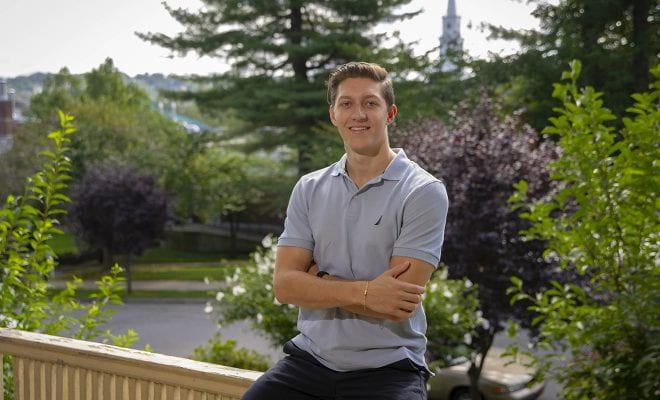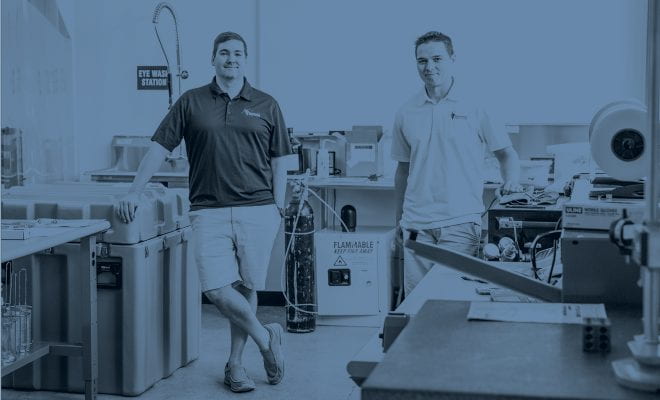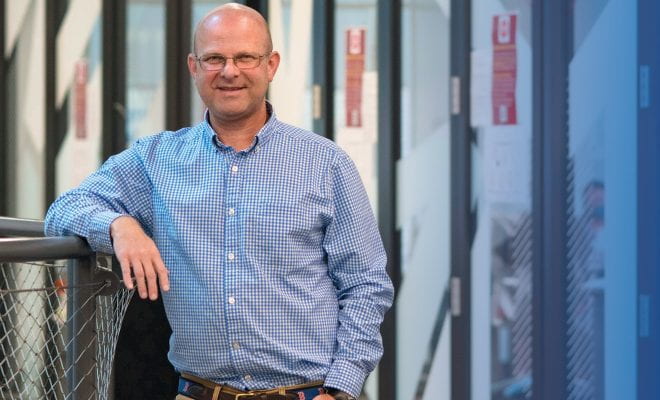“I had given up on my dream. But listening to him, I realized it was too early to give up.”
Raymond Magambo ’21
Tune into the entrepreneurial subculture at WPI and you’ll discover innovators with a bevy of ideas focused on solving real problems. Some aim to commercialize their ideas, others to refine a research technique, develop an academic project, or find new approaches to address social justice causes.
“We’re helping all innovators, not just those who are looking to start a business with their ideas,” says Curtis Abel, executive director ad interim of the Innovation and Entrepreneurship (I&E) Center. “Our vision is to inspire and develop a community of impact makers to spearhead life-changing ideas for the greater good. Whether it’s for a school project, a hobby, a business venture, a nonprofit, or research in the lab, we provide programs, experiences, mentorships, and resources.”
First and foremost, Abel notes, WPI focuses on developing people who thrive in a culture that stimulates creativity and resilience, where failure is accepted—even expected—as long as you learn from it. Impact will follow. Grounded in the project-based learning that WPI pioneered and continues to refine, the entrepreneurial ecosystem is interdisciplinary and inclusive.
Students, faculty, alumni, and staff can tap into the expertise and brain power of fellow community members, visiting experts, and successful alumni through such programs as Mentors-in-Residence and the Tech Advisors Network (TAN). Born in the WPI Business School more than a decade ago, TAN is now an expansive network of alumni, veteran entrepreneurs, and other experts, fully integrated as part of the I&E Center, and a critical partner to the Office of Technology Commercialization (OTC).
It’s about building habits, attitudes, and skills that can lead to a business, to improve society, or to be able to pivot in a workplace that we know will look very different in the years ahead.
Curtis Abel
Add to the mix educational workshops, multiple funding opportunities at all levels of idea development, activities, and resources—many sponsored by or housed within the Innovation Studio—such as makerspaces with tools and prototyping. In addition, each semester 10 teams are enrolled in the i-Corps Site Program, a National Science Foundation–funded program that provides financial and mentoring support to teams that have a promising idea addressing a market need.
“The entrepreneurial mindset is woven into the fabric of WPI—in its curriculum, co-curricular activities, and research, too,” says Abel. “It’s about building habits, attitudes, and skills that can lead to a business, to improve society, or to be able to pivot in a workplace that we know will look very different in the years ahead.”
Nurturing and Guiding
WPI opened the I&E Center––housed within The Innovation Studio but designed to infiltrate courses and collaborations in every corner of WPI—in 2017, and the team has set about nurturing and guiding those who want to start a business, as well as those who want to gain the skills to make them better at whatever they are doing.
Listening to the WPI community and understanding how their needs and goals can be shaped by specific efforts is a priority; Abel says the casual conversations he might have standing in a line or walking to a meeting brings the kind of results that make a difference in how his team approaches their work.
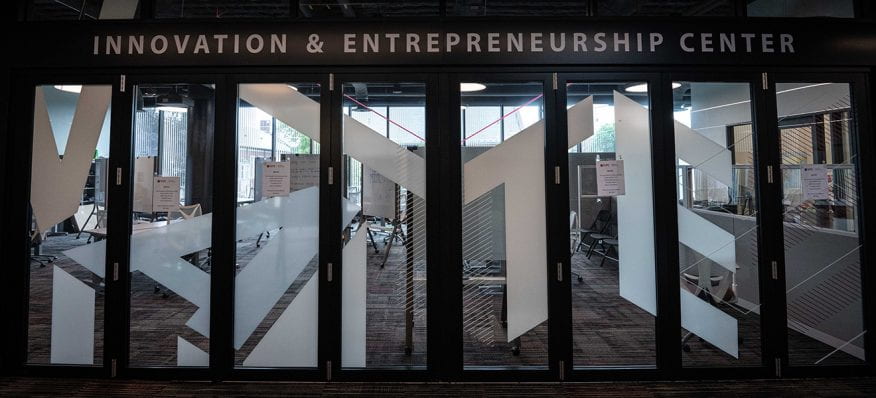
The Innovation and Entrepreneurship Center in the Innovation Studio
Over a dozen programs are geared to a specific step in the I&E journey—inspire, build, or elevate. Some activities are open to the entire campus and anyone may join the center’s formal pitch competitions, the beloved annual WinterSession (a three-day event that gives students, alumni, faculty, and staff the chance to participate in classes and workshops on a variety of topics), or the more casual OpenSpace events (intentionally unstructured meetings to share ideas). Faculty and students come together to challenge each other to apply the I&E skillset—often a mindset—to a project. There are hackathons that inspire students to apply their ideas and knowledge to social issues, and through the I&E Sandbox, students get course credit for creating an innovation or venture through one of their required project experiences.
Infused throughout WPI’s approach to innovation is the concept of value creation, guided by the Curtis and Dudley Carlson Value Creation Initiative (VCI, see sidebar). This multipronged initiative challenges and teaches students, faculty, and staff to refine their problem-solving approach. Researchers, for example, can go through the VCI’s interactive process of feedback and presentation to clarify and distinguish their value proposition. Because they can clearly articulate how their approach solves a problem in a way no one else has ever done before, they greatly increase their chances of landing a coveted grant or seed funding.
“We want to develop these timeless skills across all disciplines,” says Abel. “Even if our graduates aren’t interested in starting their own businesses, we want employers to recognize they have mastered fundamental skills in developing innovative solutions with extra-ordinary value to problems that matter.”
Student-Driven Ideas
Sometimes the spark of a good idea just needs some fanning to help it burn brightly. Raymond Magambo ’21 (MS, IT) credits Abel, Senior Associate Director of Innovation & Entrepreneurship Kristie DeJesus, and Provost Winston “Wole” Soboyejo with reigniting his dream of transforming bus ticketing in his home country of Tanzania.
Magambo says he came to WPI in search of new ideas after the failure of his start-up Tiketi Rafiki (translation: Friendly Ticket). More than 60,000 Tanzanians use the bus system daily, exhausted and frustrated by the long drive to overcrowded stations, while unscrupulous sellers can make buying tickets in person dangerous. Magambo launched his electronic platform in 2016, but he ran into issues with a third-party payment system that made the company financially unworkable. Feeling discouraged after devoting three years of his life to the venture, he shut down the business and decided to go abroad to earn an advanced degree.
Early in his master’s program within The Business School, he happened to be in the Innovation Studio when DeJesus started a conversation that led to his attending a talk about to start. One of the three speakers was a 60-year-old entrepreneur who detailed the ups and downs and ongoing efforts to grow his start-up. Magambo says he had “a life-changing moment” listening to this much older man who was still enthusiastically driving to succeed.
“I had given up on my dream,” he says. “But listening to him, I realized it was too early to give up. I called my team on the same day, and said, ‘We have to go back into business.’ From there, everything started over.”

Encouraged by the I&E staff, Magambo applied for and was accepted into WPI’s Tinkerbox program, which provides seed money, mentorship opportunities, and educational workshops. He put the $2,000 toward updating the platform with a new mobile payment system sponsored by the Tanzania government. Magambo and his team expect to be up and running in the fall of 2021, once the business license is in hand and contracts with bus operators are signed. In addition, he’s one of two student innovation fellows in the I&E Center, where he works as a business program coordinator.
From Idea to Commercialization
In another leg of the I&E journey, when innovators want to commercialize their ideas, the way forward is through the Office of Technology Commercialization and the technical and financial expertise found there. According to Todd Keiller, OTC director, the guidance provided by his three-person team and their partners from TAN has cultivated multiple start-ups, a few of which he’s confident are on the cusp of eye-popping success.
“Ten years ago, there was not one active license, not one startup,” that spun out of WPI laboratories, says Keiller. The landscape looks quite different today.
Now, the OTC is helping 21 startups that have raised more than $130 million in investment money and created over 100 jobs, mostly in the Worcester area. In addition, 50 active licenses that have been spun out of WPI research have the potential to provide significant non-tuition revenue in the form of royalties.
If faculty members, students, or teams of both believe their idea is commercially viable, they complete an invention disclosure form, which sets off research into “prior art” to see if the idea has already been patented or licensed. Once that search comes up clear, the office works with one of several attorneys, most of whom are WPI alumni, to file a provisional patent.
“That puts a stake in the ground and protects the idea,” says Keiller. “It gets expensive one year from the filing of the provisional patent. OTC assists the applicants in finding an existing company to license the patent, create a start-up company to grow the idea, or re-file the provisional patent if there hasn’t been a public disclosure.”
OTC encourages inventors who have recently filed a provisional patent to enroll in the i-Corps Site Program. Under the mentorship of alumni and others, teams complete a minimum of 30 customer interviews over a nine-week period.
“It is amazing how a team’s value proposition changes from the first class to the last based on customer input,” Keiller says. “This makes for a better patent application and focuses the intellectual property on satisfying a real unmet customer need.”

Todd Keiller
“The real traction on the start-ups and economic development is through faculty-led intellectual property.”
Todd Keiller
Faculty involvement can be an indicator of how likely an idea is to make it through to successful commercialization. At WPI, 30% of intellectual property filings are completed by faculty, with an additional 50% by faculty-student teams.
“The real traction on the start-ups and economic development is through faculty-led intellectual property,” says Keiller, citing national studies that show the “spin-out” success rate is much higher for faculty and/or grad student work.
Equally essential to a healthy entrepreneurial support system is the Commercialization Fund, which provides critical early funding for nascent enterprises in exchange for equity. Created in 2012 with more than $550,000 in private donations, the fund’s investments are relatively small—around $25,000 in most cases—but can provide breathing space for start-ups, allowing them to build prototypes, complete market research, and bridge the gap to larger external investments. While not all investments pay off, the successful bets are expected to compensate for the failures so the fund will remain evergreen.
Battery Resourcers Charges Forward
Perhaps the furthest along in the commercialization pipeline is Battery Resourcers, a company founded in 2015 as a spinoff from the lab of Professor Yan Wang. Co-founded by Wang’s former postdoc Eric Gratz, the company solved the conundrum that had long stymied the burgeoning electric car market: how to efficiently recycle the spent lithium-ion batteries that power the industry.
To fully recover the lithium, cobalt, nickel, manganese, graphite, and other materials in lithium-ion batteries, a recycler needs to be able to go beyond traditional methods that are unable to capture everything. Over the course of several years, Wang, Gratz, and Diran Apelian, founding director of WPI’s Metal Processing Institute, figured out how to break down the entire battery to recover the material, and then use that recycled material to create new battery elements, all in a single process.

“It’s an environmentally closed loop,” says Keiller. “They take in batteries, shred them, treat them, and recover almost all the materials, which go back into making new batteries. There’s no waste, no pollution in the process. That’s pretty darn exciting.”
The company has just closed a $70 million round of financing, and recently signed an agreement with American Honda Motor Co. to recycle Honda and Acura electric vehicle batteries. Those batteries will initially be processed at Battery Resourcers’ expanded site in Worcester and later at a new commercial-scale plant, scheduled to be operational in the spring of 2022. The company is expected to jump from 28 to 61 employees as a result.
This expansion, plus plans to build other full-scale commercial plants around the world, will require next-level funding, for which there is already significant interest. With the Big Three automakers pledging that up to 50 percent of the cars they sell annually will be battery electric, plug-in hybrid, and powered by fuel cells by 2030, it’s clear the market for recycling spent lithium-ion batteries is about to explode, adding urgency to the expansion.
“They’ve been told by car companies that ‘You have to grow faster because your solution is the best one out there,’” says Keiller.
WPI has equity in the licensing of the intellectual property, and the Commercialization Fund was an early investor. “Our $25,000 initial investment and our patents are now worth over $1 million from the last round of seed funding,” says Keiller. “When it goes public, who knows what it will be worth?”
A Sensor for the Road
While Battery Resourcers is well into its journey to commercial success, Roadgnar is just starting out. The year-old venture was founded by Class of 2020 graduates Daniel Pelaez, Noah Budris, and Noah Parker based on technology they unlocked as students.
The trio devised a way to attach a sensor to the back of any vehicle to 3D scan and analyze the condition of a road. In addition to winning a $10,000 prize from the SICK, Inc., LiDAR Challenge, they worked with OTC to secure a provisional patent. Pelaez and Budris also went through the i-Corps program and spent their junior year interviewing potential customers across New England for market research.
They received help from I&E’s Tinkerbox program, as well as TAN, including Jeremy Hitchcock ’04, co-founder and former CEO of both Minim, Inc., and DynCorp, who provided Pelaez with some veteran guidance when he needed it most.
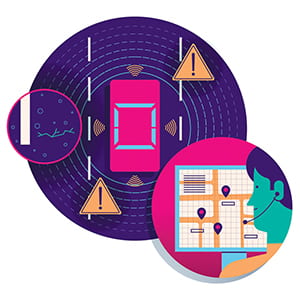
“We were working every night building Roadgnar while also working our full-time jobs,” says Pelaez. At a crossroads, wondering if all the effort was worth it, Pelaez asked Hitchcock whether he thought the business was viable. “He pretty much said, ‘Go for it,’ which was all I needed to hear. I put in my two weeks at my nice, comfy engineering job and then focused on raising funds from investors. Three months later, we had cash in the bank and my co-founders quit their day jobs as well,” he says.
In addition to early seed money and expert guidance from I&E and OTC, an investment from WPI’s Commercialization Fund gave them a boost of confidence—and some financial breathing room.
Roadgnar’s original business model focused on using the sensors to track potential problems with roadways, allowing public works departments to anticipate deteriorating pavement even before potholes materialized. Municipal governments often rely on expensive external engineering companies for analysis of roads, or simple visual inspection of conditions by town employees.
“The way cities and towns manage their infrastructure today is mostly reactive,” says Pelaez. “If something breaks, they fix it. If a citizen complains, or someone gets injured, then they fix it. We wanted them to start being more proactive dealing with these issues.”
The City of Worcester is currently piloting the technology and many other municipalities across the country have expressed interest in Roadgnar’s innovative solution. The sensors are now small enough to be secured to municipal vehicles, such as trash trucks, so the data can be sent back wirelessly on a regular basis in a passive way.
“Deploying these low-cost sensors allows for infrastructure to be monitored year-round so towns and cities can catch things before they become an issue,” he says. “A pothole doesn’t appear overnight.”
The WPI-led team also includes Bryan Licciardi ’03, who recently came aboard as the lead data scientist. Once the team proves the technology works in Worcester, it plans to scale up to serve other municipalities across the United States.
Bringing Ideas to Life
A strong support system grows innovative ideas and encourages students to think as innovators or entrepreneurs in everything they do—classwork, extracurricular activities, jobs, hobbies, or start-ups. In addition, it also helps attract and retain innovative faculty members, many of whom are actively investigating such resources when considering job opportunities. Many start-ups spun out of WPI also put down roots in the local area, providing jobs and stimulating the local economy.
“We provide these resources—seed funding, mentorship, Commercialization Fund investments, innovation fellowships—for students and faculty,” says Abel. “We want them to know, ‘We are here for you to help you bring your innovative ideas to life.’”
Creating Value with Purposeful Work
The guiding principle of meaningful work and doing research with purpose permeates everything at WPI—from classroom work to projects to research. A new initiative here takes the principle a step further by addressing the gray area of discovery—if you solve a problem, but the solution doesn’t bring anything new to the table or doesn’t fill a real need, did that work create any new value?
WPI’s recently launched Value Creation Initiative (VCI) teaches students, faculty, and staff tactics to ensure the hours they spend in labs, classrooms, and offices have the greatest impact possible. The process distills the intent of work to a “nugget” that identifies a specific need and determines the best solution to solve the problem for the stakeholder.
The process distills the intent of work to a “nugget” that identifies a specific need and determines the best solution to solve the problem for the stakeholder.
VCI founders and WPI executives-in-residence Curt Carlson ’67 and Len Polizzotto ’72 believe that everyone must deliver value to stakeholders—whether that’s a funding agency, a professor, a project sponsor, or a supervisor. Value creation teaches strategies using the fundamental principles of the NABC (Need, Approach, Benefit/Costs, and Competition) value proposition framework. With NABC, students, faculty, and staff learn specific steps so their work solves problems that matter to other people.
When value creation is used consistently, the entire university community benefits. As faculty members narrow a grant proposal focus in a value creation forum, their chances of landing significant funding awards, for their research and WPI, increase. They use feedback, iteration, and the application of core value creation concepts to answer the most important question a funding agency has: Why should they fund this researcher for this project over everyone else?
In turn, they pass along this new knowledge to students. As students gain value creation literacy, greater success and project impact result—accompanied by a boost in professional confidence and competence. Through the process, students apply fundamental skills that improve their immediate work and prepare them to be workforce ready at graduation.
According to Carlson, WPI’s project work creates the ideal working environment for putting value creation into a real practice; it also creates a new distinction for WPI. The goal of student projects is not just to complete a task, he says, but to deliver value and solutions that matter to others. “Only WPI has embraced that perspective,” he says.
—Julia Quinn-Szcesuil
Related article: Value Creation—the Next Step Beyond Theory and Practice




